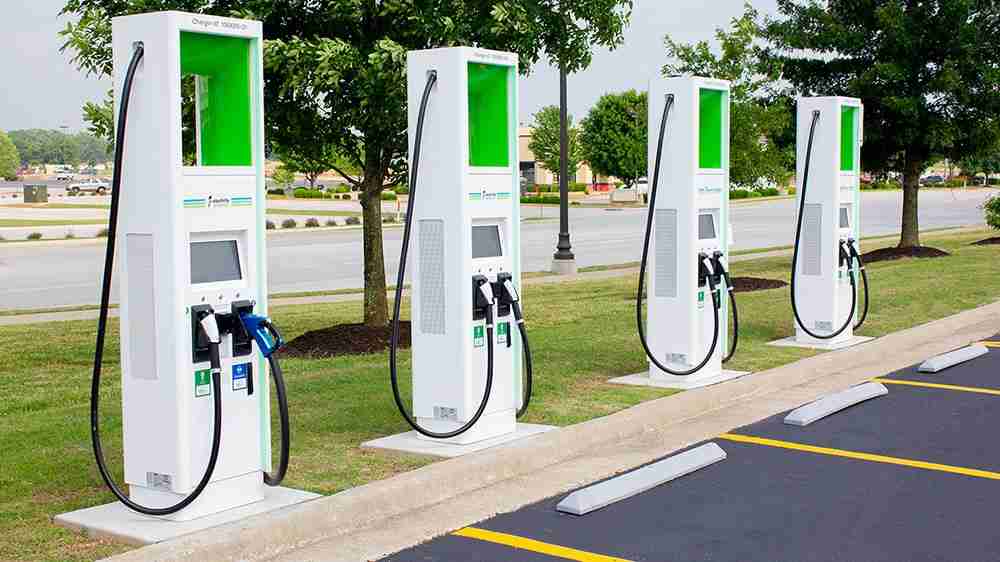Introduction
The rise of electric vehicles (EVs) is playing a crucial role in reducing carbon emissions and mitigating climate change. However, the sustainability of EV adoption is closely tied to the energy sources powering charging stations. As the electric vehicle charging station market expands, integrating renewable energy solutions and improving energy efficiency are becoming critical factors in maximizing environmental benefits. This article explores the sustainability impact of EV charging stations, their role in carbon reduction, and the future outlook for a cleaner transportation ecosystem.
The Role of EV Charging Stations in Sustainability
EV charging stations serve as the backbone of electric mobility, ensuring accessibility and convenience for EV owners. However, to achieve a truly sustainable transportation system, charging infrastructure must prioritize clean energy integration and energy-efficient solutions.
1. Integration of Renewable Energy Sources
Many charging stations are being powered by solar, wind, and hydroelectric energy to reduce dependence on fossil fuels.
Companies are investing in on-site solar panels and battery storage systems to provide a self-sustaining energy supply.
Smart grid technology enables charging stations to draw power from renewable sources when availability is high, reducing carbon footprint.
2. Reducing Carbon Emissions
Charging stations powered by clean energy drastically lower greenhouse gas emissions compared to traditional gasoline-powered vehicles.
Lifecycle assessments indicate that an EV charged using renewable energy can reduce emissions by up to 80% compared to internal combustion engine (ICE) vehicles.
The shift to sustainable charging solutions aligns with global climate goals such as net-zero carbon emissions by 2050.
Key Strategies for Sustainable EV Charging Infrastructure
To maximize sustainability, EV charging infrastructure is evolving with several innovative approaches:
1. Smart Charging and Energy Management
Smart charging technology optimizes energy use by adjusting charging speeds based on grid demand and renewable energy availability.
Vehicle-to-grid (V2G) solutions allow EVs to feed excess energy back into the grid, helping to balance electricity demand.
2. Ultra-Fast Charging with Energy Efficiency
New ultra-fast chargers are being developed with improved energy efficiency to minimize waste and lower overall electricity consumption.
High-efficiency cooling systems are being integrated to enhance charger performance and reduce energy loss.
3. Use of Recycled and Sustainable Materials
EV charging stations are increasingly utilizing sustainable building materials, such as recycled steel and environmentally friendly insulation.
Charging cables and station components are being designed with biodegradable or recyclable materials to reduce environmental impact.
4. Decentralized and Off-Grid Charging Solutions
Off-grid charging stations powered by solar panels and battery storage are being deployed in remote and urban areas to reduce reliance on traditional power sources.
Microgrid technology enables communities to operate independent, sustainable charging networks, reducing strain on national grids.
Global Initiatives Supporting Sustainable Charging Infrastructure
Governments and private entities worldwide are implementing policies and incentives to promote the sustainability of EV charging stations.
1. North America
The U.S. and Canada are investing in renewable-powered charging networks as part of their climate action plans.
Companies like Tesla, ChargePoint, and Electrify America are expanding solar-powered charging hubs.
2. Europe
The European Union’s Green Deal mandates the transition to 100% renewable energy in public charging infrastructure.
Ionity and BP Pulse are integrating wind and solar energy into their ultra-fast charging networks.
3. Asia-Pacific
China leads the world in solar-powered EV charging stations, with government-backed initiatives supporting clean energy integration.
Japan and South Korea are innovating in hydrogen-based charging solutions as part of their carbon neutrality goals.
Challenges in Achieving a Fully Sustainable Charging Network
Despite advancements, several challenges must be addressed to ensure widespread sustainable EV charging adoption.
1. High Initial Costs
The cost of integrating renewable energy sources into charging stations remains high, requiring significant investment from governments and private companies.
2. Energy Storage Limitations
Battery storage technology needs further advancements to ensure consistent energy supply from renewable sources, especially during periods of low sunlight or wind.
3. Grid Infrastructure Upgrades
Many electrical grids are not yet optimized to handle widespread EV charging demand, requiring upgrades to support renewable energy integration.

Future Outlook for Sustainable EV Charging
The future of EV charging is centered around sustainability, with continued efforts to expand renewable-powered infrastructure and energy-efficient solutions. Advancements in solid-state batteries, AI-driven energy management, and improved charging station design will further enhance the environmental benefits of EV adoption.
Conclusion
The EV charging station market is evolving to become more sustainable, playing a critical role in global carbon reduction efforts. By integrating renewable energy sources, improving efficiency, and leveraging smart charging technology, the industry is moving towards a greener and more resilient future. Overcoming current challenges will be key to achieving a fully sustainable EV charging ecosystem, ensuring long-term benefits for both the environment and future generations.



